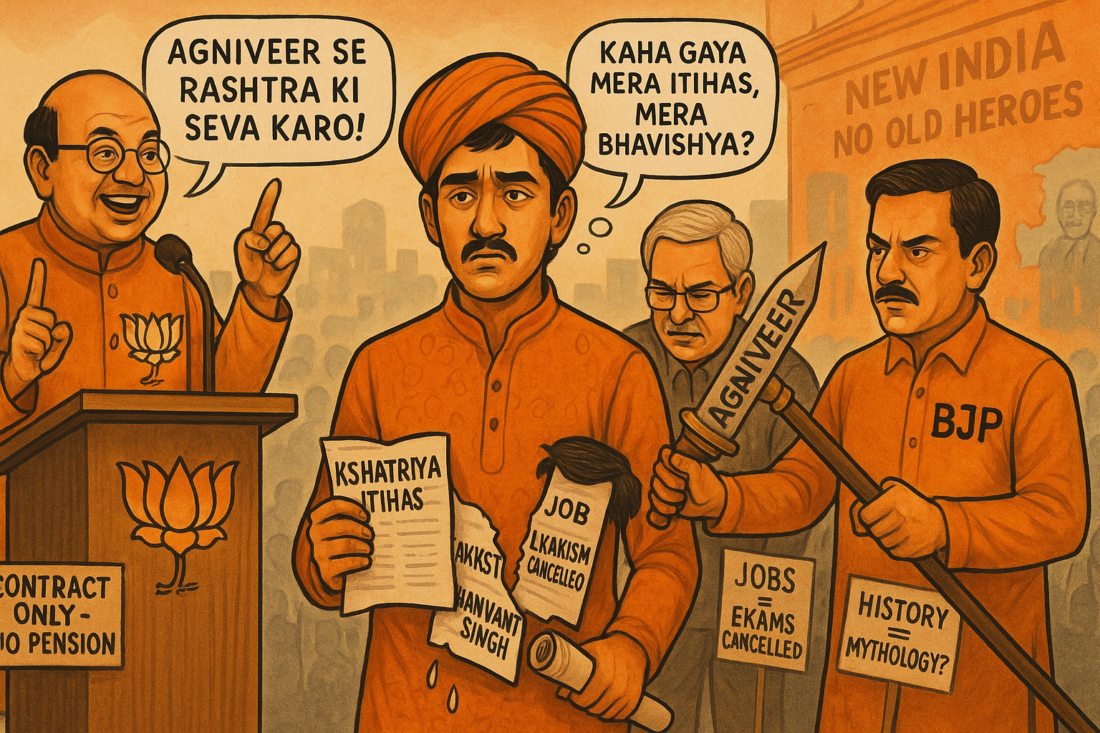Hindutva’s Betrayal of Rajputs and the Case for Independent Politics
I. Introduction
The story of Rajput political alignment with the Bharatiya Janata Party (BJP) is not one of ideological conviction but of historical compulsion. From the early years of Indian independence, Rajputs found themselves caught between the hammer of Nehruvian Brahmin-Bania elitism and the anvil of Lohia’s Bania-Jat-Ahir caste-based politics. Their land, prestige, and political space shrank rapidly, forcing many to reluctantly align with the rising tide of Hindutva—first through the Jan Sangh, and later the BJP.
Yet, as the BJP grew from a fringe formation into the dominant political force of India, the Rajputs who once powered its rural engine found themselves sidelined—politically ignored, culturally appropriated, and administratively repressed.
This essay explores this arc: the pre-1990 political shifts, the Rajput investment in the BJP, the systematic betrayal that followed, and why Rajput politics must now break free to reclaim its autonomy.
A. The History of Rajput’s Tryst with BJP-RSS
I. The Post-1947 Landscape: The Fall of the Rajput Aristocracy
1. Abolition of Princely States & Privy Purses
-
The merger of princely states and the abolition of privy purses by Indira Gandhi in 1971 was a decisive blow to Rajput power.
-
Over 40% of Rajasthan’s land and leadership had been under Rajput thikanas and riyasats. Their abrupt liquidation created both an economic and psychological rupture among Rajput elites.
2. Nehruvian Socialism and Land Reforms
-
Post-independence land reform acts like the Zamindari Abolition Act (1950s) and Rajasthan Tenancy Act (1955) targeted the landed aristocracy, disproportionately affecting Rajputs.
-
These reforms often favored politically connected Brahmin and Bania castes, while Rajput holdings were fragmented or transferred, often with little or no compensation.
3. Marginalization by Congress
-
The Congress Party under Nehru and later Indira Gandhi saw the Rajputs as vestiges of feudalism and deliberately denied them leadership roles.
-
Brahmins, Banias, and later OBCs were better integrated into the party’s electoral calculus, leaving Rajputs politically homeless.
III. Jan Sangh and the Early Hindutva Outreach
1. Rajput Pragmatism, Not Ideological Faith
-
The Jan Sangh, founded in 1951 by Syama Prasad Mukherjee, attracted upper-caste support—but Rajputs were initially wary due to its Brahmin-Bania dominance and RSS’s urban appeal.
-
However, by the 1970s, Rajputs like Bhairon Singh Shekhawat began allying with the Jan Sangh due to:
-
Marginalization by Congress
-
Shared opposition to land reform
-
The need to counter rising Jat dominance in rural belts
-
2. The Rise of Bhairon Singh Shekhawat
-
A self-made Rajput politician from Sikar, Shekhawat rose through the Jan Sangh–Janata Party alliance, becoming Rajasthan’s Chief Minister in 1977 and again in 1990 and 1993.
-
His success created a Rajput-Bania-Brahmin coalition that gave rural elites a political base against both Congress and rising OBC formations.
IV. The 1990s: Rajputs Power the BJP’s Rural Surge
1. The Mandal-Mandir Moment
-
The Mandal Commission (1989) catalyzed the consolidation of OBC identity, leaving Rajputs politically isolated.
-
The Ram Janmabhoomi movement, led by BJP and RSS, offered a platform to rally Rajput youth around Hindu pride and martial symbols.
-
Rajputs participated as street-level cadres, organizers, and foot-soldiers in kar seva, seeing Hindutva as a vehicle to regain lost prestige.
2. Rajput Support Transforms BJP in Rajasthan, UP, MP
-
BJP’s success in North India during the 1990s heavily depended on Rajput vote banks and organizational manpower.
-
Leaders like Jaswant Singh, Shekhawat, and Rajnath Singh gave the BJP its rural and upper-caste credibility.
V. Post-2014: The Great Betrayal
1. Systematic Political Marginalization
-
BJP moved from a Rajput-friendly party to an OBC-dominated caste coalition, especially in Uttar Pradesh (under Yogi Adityanath) and Madhya Pradesh.
-
Jaswant Singh was denied a ticket in 2014, humiliated, and expelled.
-
Rajnath Singh was reduced to insignificance in decision-making.
2. Cultural Co-option and Insult
-
BJP uses Rajput icons—Maharana Pratap, Prithviraj Chauhan—but erases the pluralism and nuance of their histories.
-
In the Padmavat protests (2017), Rajput demands were crushed by BJP state governments while fringe groups were delegitimized.
-
RSS reinterpretation of history downplays Rajput-Mughal alliances, Sufi patronage, and their non-Hindutva regional dharma.
3. Administrative Violence and Lawfare
-
In BJP-ruled states, Rajput youth protesting caste issues or cultural dilution have been met with sedition charges, arrests, or political exclusion.
-
In Uttar Pradesh, Thakur-Rajput youth have faced disproportionate “encounter policing”, especially when rivaling OBC political blocs.
B. Ideological Foundations of Hindutva and Rajput Marginalization
1. Golwalkar’s Vision of Nationhood
M.S. Golwalkar, the second Sarsanghchalak of the RSS, articulated a vision of India as a Hindu Rashtra in his 1939 work We, or Our Nationhood Defined. He emphasized a homogeneous national identity based on five unities: geographical, racial, religious, cultural, and linguistic. Golwalkar wrote:saafbaat.com+6en.m.wikiquote.org+6caravanmagazine.in+6saafbaat.com+2goodreads.com+2hindutvawatch.org+2
“The foreign races in Hindusthan must either adopt the Hindu culture and language, must learn to respect and hold in reverence Hindu religion… or may stay in the country, wholly subordinated to the Hindu nation, claiming nothing, deserving no privileges, far less any preferential treatment—not even citizen’s rights.” newslaundry.com+3en.m.wikiquote.org+3hindutvawatch.org+3
This perspective promotes a singular cultural identity, potentially sidelining the diverse traditions within Hinduism, including the distinct Rajput heritage.
2. Emphasis on Brahminical Hierarchy
Golwalkar’s admiration for the Varna system, particularly the role of Brahmins, is evident in his writings. He viewed the caste system as integral to societal stability, stating:telegraphindia.com
“The so-called ‘caste-ridden’ Hindu Society has remained undying and unconquerable… while casteless societies crumbled to dust.” theprint.in
Such views reinforce a hierarchical structure that may marginalize Kshatriya groups like the Rajputs, whose martial traditions and regional identities differ from the Brahminical norms emphasized in Hindutva ideology.
Implications for the Rajput Community
1. Political Marginalization
Despite their early support, Rajput leaders have often found themselves sidelined within the BJP. The party’s focus on consolidating OBC and Dalit votes has sometimes come at the expense of traditional upper-caste allies, leading to reduced political influence for Rajputs.
2. Cultural Assimilation
The homogenizing tendencies of Hindutva may dilute the unique cultural practices and historical narratives of the Rajput community. By promoting a singular Hindu identity, the rich tapestry of regional traditions faces the risk of being overshadowed.
C. Why Rajput Politics Must Break Free From BJP : Why Rajput Youth Must Reject Hindutva
1. Hindutva Is Inherently Brahminical
-
Golwalkar’s writings glorify caste hierarchy, favoring Brahmins as ideological leaders and Kshatriyas as obedient protectors—not independent rulers.
-
The RSS ecosystem remains Bania-Brahmin controlled, where Rajputs are expected to fight but not rule.
-
It Is Anti-Kshatriya in Spirit. Hindutva glorifies the Kshatriya warrior in rhetoric but suppresses real Rajput agency. It wants Rajputs to be loyal foot-soldiers, not political leaders or cultural shapers.
2. Historical Rajput Dharma Was Regional and Plural
- It Betrays Religious Pluralism Rajputs Historically Lived
-
Many Rajput rulers had alliances with Muslims, gave patronage to Jain, Sufi, and Bhakti traditions, and married across ethnic boundaries.
-
Rajput ethos is about honor and regional sovereignty, not religious majoritarianism.
3. Rajputs Need Political and Cultural Autonomy
-
Rajput youth must strive for regional political platforms, cultural preservation societies, and academic reclamation of their history.
-
They must fight both upper-caste Brahminical dominance and majoritarian Hindutva simplifications.
4. Advocating Religious Pluralism over Hindutva
- Rajput values of dharma, honor, and sovereignty align more with religious pluralism and regional autonomy than with homogenizing Hindutva.
- The future lies in alliances with S, Scheduled Castes and other regional martial groups to reclaim political relevance outside the BJP-RSS axis.
Given these dynamics, there is a compelling argument for the Rajput youth to critically assess their alignment with Hindutva ideology. Embracing religious pluralism and advocating for a more inclusive national narrative can help preserve the distinct cultural identity of the Rajput community while promoting unity in diversity.
In conclusion, while the Rajputs have significantly contributed to the BJP’s ascent in North India, the ideological framework of Hindutva, as outlined by Golwalkar, presents challenges to the preservation of their unique cultural and political identity. A re-evaluation of this relationship, with an emphasis on pluralism and inclusivity, may better serve the community’s long-term interests.
D. The Way Forward: Rajput Regional Republicanism
Rajput youth must now look beyond both the Congress and BJP and embrace an independent, assertive political and cultural path rooted in their own regional identity, historical legacy, and democratic ethos.
1. Build Independent Political Platforms
-
Create Rajput-centric political formations that draw strength from Rajputana’s legacy of decentralized rule, peasant-military solidarity, and rural honor.
-
These platforms must reject both BJP’s tokenism and Congress’s casteist marginalization, focusing instead on justice, dignity, and regional autonomy.
2. Break Free from Brahmin-Bania-Jat-Ahir Nexus
-
Rajputs must confront and reject alliances with castes that actively distort or appropriate Rajput history—particularly Jats, Ahirs, and Gujjars, whose political organizations and intellectual narratives often vilify or erase Rajput contributions.
-
These groups have repeatedly collaborated with Brahmin-Bania intellectuals and political networks to undermine Rajput legacy, both in academia and electoral politics.
3. Reclaim Intellectual and Cultural Sovereignty
-
Invest in Rajput-led historical research, digital archives, regional language publications, and cultural institutions.
-
Promote media platforms, think tanks, and student networks that assert Rajput identity in modern language—grounded in honor (maryada), dignity (swabhimaan), and justice (nyaya).
4. Forge New, Ethical Alliances
-
Rajputs can build selective alliances with marginalized communities who are victims of the same Brahmin-Bania political manipulation—Adivasis, oppressed backward agrarian castes (outside the anti-Rajput bloc), and independent regional groups who value autonomy over ideological servitude.
-
These alliances must be based on mutual respect, not erasure or appropriation.
VII. Conclusion
The Rajput journey through Jan Sangh and BJP politics was not born out of Hindutva conviction—it was a political refuge from Nehruvian land reforms and casteist Congress politics. What began as survival politics turned into cultural captivity. The Rajputs gave the BJP its rural spine, but were discarded once the party achieved its national ambition.
Now is the time to break this cycle. Rajputs must reclaim their political destiny—not as symbolic guardians of a borrowed ideology, but as autonomous agents of regional, plural, and democratic power.

